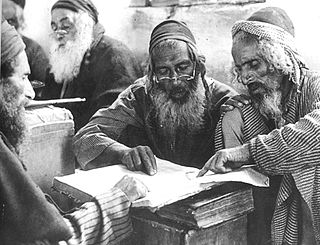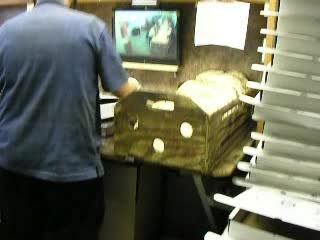
The Mishnah or the Mishna is the first major written collection of the Jewish oral traditions that are known as the Oral Torah. It is also the first major work of rabbinic literature. The Mishnah was redacted by Judah ha-Nasi probably in Beit Shearim or Sepphoris between the ending of the second century and the beginning of the 3rd century CE in a time when the persecution of Jews and the passage of time raised the possibility that the details of the oral traditions of the Pharisees from the Second Temple period would be forgotten.

The Gemara is an essential component of the Talmud, comprising a collection of rabbinical analyses and commentaries on the Mishnah and presented in 63 books. The term is derived from the Aramaic word גמרא and rooted in the Semitic word ג-מ-ר (gamar), which means "to finish" or "complete". Initially, the Gemara was transmitted orally and not permitted to be written down. However, after Judah the Prince compiled the Mishnah around 200 CE, rabbis from Babylonia and the Land of Israel extensively studied the work. Their discussions were eventually documented in a series of books, which would come to be known as the Gemara. The Gemara, when combined with the Mishnah, forms the full Talmud.
The Sadducees were a sect of Jews active in Judea during the Second Temple period, from the second century BCE to the destruction of the Second Temple in 70 CE. The Sadducees are described in contemporary literary sources in contrast to the two other major sects at the time, the Pharisees and the Essenes.

Yemenite Hebrew, also referred to as Temani Hebrew, is the pronunciation system for Hebrew traditionally used by Yemenite Jews. Yemenite Hebrew has been studied by language scholars, many of whom believe it to retain older phonetic and grammatical features lost elsewhere. Yemenite speakers of Hebrew have garnered considerable praise from language purists because of their use of grammatical features from classical Hebrew. Tunisian rabbi and scholar, Rabbi Meir Mazuz, once said of Yemenites that they are good grammarians.
Capital punishment in traditional Jewish law has been defined in Codes of Jewish law dating back to medieval times, based on a system of oral laws contained in the Babylonian and Jerusalem Talmud, the primary source being the Hebrew Bible. In traditional Jewish law there are four types of capital punishment: a) stoning, b) burning by ingesting molten lead, c) strangling, and d) beheading, each being the punishment for specific offenses. Except in special cases where a king can issue the death penalty, capital punishment in Jewish law cannot be decreed upon a person unless there were a minimum of twenty-three judges (Sanhedrin) adjudicating in that person's trial who, by a majority vote, gave the death sentence, and where there had been at least two competent witnesses who testified before the court that they had seen the litigant commit the offense. Even so, capital punishment does not begin in Jewish law until the court adjudicating in this case had issued the death sentence from a specific place on the Temple Mount in the city of Jerusalem.
Johanan bar Nappaha was a leading rabbi in the early era of the Talmud. He belonged to the second generation of amoraim.

Bava Batra is the third of the three Talmudic tractates in the Talmud in the order Nezikin; it deals with a person's responsibilities and rights as the owner of property. It is part of Judaism's oral law. Originally it, together with Bava Kamma and Bava Metzia, formed a single tractate called Nezikin.

The tithe is specifically mentioned in the Books of Leviticus, Numbers and Deuteronomy. The tithe system was organized in a seven-year cycle, the seventh-year corresponding to the Shemittah-cycle in which year tithes were broken-off, and in every third and sixth-year of this cycle the second tithe replaced with the poor man's tithe. These tithes were akin to taxes for the people of Israel and were mandatory, not optional giving. This tithe was distributed locally "within thy gates" to support the Levites and assist the poor. Every year, Bikkurim, terumah, ma'aser rishon and terumat ma'aser were separated from the grain, wine and oil. Initially, the commandment to separate tithes from one's produce only applied when the entire nation of Israel had settled in the Land of Israel. The Returnees from the Babylonian exile who had resettled the country were a Jewish minority, and who, although they were not obligated to tithe their produce, put themselves under a voluntary bind to do so, and which practice became obligatory upon all.
The House of Hillel and House of Shammai were, among Jewish scholars, two schools of thought during the period of tannaim, named after the sages Hillel and Shammai who founded them. These two schools had vigorous debates on matters of ritual practice, ethics, and theology which were critical for the shaping of the Oral Law and Judaism as it is today.
In Jewish law, a chazakah is a legal presumption; it establishes burden of proof. There exist many such presumptions, for example regarding the ownership of property, a person's personal status, and presumptions about human behavior.
Usucapio was a concept in Roman law that dealt with the acquisition of ownership of something through possession. It was subsequently developed as a principle of civil law systems, usucaption. It is similar to the common law concept of adverse possession, or acquiring land prescriptively.
Kil'ayim are the prohibitions in Jewish law which proscribe the planting of certain mixtures of seeds, grafting, the mixing of plants in vineyards, the crossbreeding of animals, the formation of a team in which different kinds of animals work together, and the mixing of wool with linen in garments.

In Judaism, the dough offering is an assertive command requiring the owner of bread dough to give a part of the kneaded dough to a kohen. The obligation to separate the dough offering from the dough begins the moment the dough is kneaded, but may also be separated after the loaves are baked. This commandment is one of the twenty-four kohanic gifts, and, by a biblical injunction, is only obligatory in the Land of Israel, but from a rabbinic injunction applies also to breadstuffs made outside the Land of Israel.
Impurity of the land of the nations is a rabbinic edict stipulating a specified degree of tumah (impurity) on all lands outside the Land of Israel. The demarcation lines of foreign lands effectually included all those lands not settled by the people of Israel during their return from the Babylonian exile during the Second Temple period, and was meant to dissuade the priests of Aaron's lineage from venturing beyond the Land of Israel where graves were unmarked, and who may inadvertently contract corpse uncleanness and thereby eat their bread-offering (Terumah), unawares, in a state of ritual impurity and becoming liable thereby to kareth. The declaration with respect to foreign lands includes also the "virgin soil" of those lands, and was, therefore, a safeguard meant to prevent the priests from inadvertently transgressing the Law of Moses.
Dina d'malkhuta dina is a principle in Jewish religious law that the civil law of the country is binding upon the Jewish inhabitants of that country, and, in certain cases, is to be preferred to Jewish law. The concept of dina de-malkhuta dina is similar to the concept of conflict of laws in other legal systems. It appears in at least twenty-five places in the Shulchan Arukh.
Sicaricon, lit. 'usurping occupant; possessor of confiscated property; the law concerning the purchase of confiscated property', refers in Jewish law to a former act and counter-measure meant to deal effectively with religious persecution against Jews in which the Roman government had permitted its own citizens to seize the property of Jewish landowners who were either absent or killed in war, or taken captive, or else where Roman citizens had received property that had been confiscated by the state in the laws prescribed under ager publicus, and to which the original Jewish owners of such property had not incurred any legal debt or fine, but had simply been the victims of war and the illegal, governmental expropriation of such lands from their rightful owners or heirs. The original Jewish law, made at some time after the First Jewish-Roman War with Vespasian and his son Titus, saw additional amendments by later rabbinic courts, all of which were meant to safe-guard against depriving the original landowners and their heirs of any land that belonged to them, and to ensure their ability to redeem such property in the future.
Biblical mile is a unit of distance on land, or linear measure, principally used by Jews during the Herodian dynasty to ascertain distances between cities and to mark the Sabbath limit, equivalent to about ⅔ of an English statute mile, or what was about four furlongs. The basic Jewish traditional unit of distance was the cubit, each cubit being roughly between 46–60 centimetres (18–24 in) The standard measurement of the biblical mile, or what is sometimes called tǝḥūm šabbat, was 2,000 cubits.
Corpse uncleanness is a state of ritual uncleanness described in Jewish halachic law. It is the highest grade of uncleanness, or defilement, and is contracted by having either directly or indirectly touched, carried or shifted a dead human body, or after having entered a roofed house or chamber where the corpse of a Jew is lying.
Hefker beth-din hefker, "that which is declared by a court ownerless property is forthwith accounted ownerless property", is a principle in Jewish religious law that stipulates the right of a Jewish court of law in what regards jus in re aliena. The principle is derived from an episode in the Book of Ezra, where Ezra the Scribe commanded the Jewish people to return to their former country, threatening to confiscate the property of anyone who refuses to go-up to the Land of Israel, after having lived in exile.

Butts and bounds, shortened form for "abuttals and boundaries" of a property, are the boundary lines delineated between plots of land, usually those which define the end of an estate, as used in legal deeds, titles, etc. These are usually descriptive features in the property, such as trees, outcroppings of stone, or riverine brooks, etc., and are signified in the legal deed for purposes of identification.






